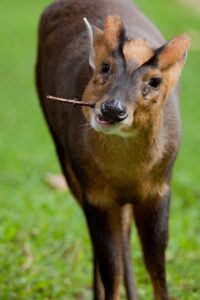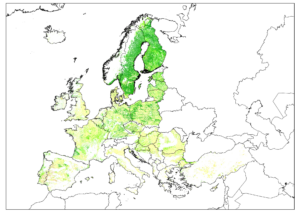Achieving European freedom from a major invasive alien species: Reeves’ muntjac

Reeves’ muntjac buck (male).
Credit: Alfonsopazphoto, CC BY-SA 3.0 <https://creativecommons.org/licenses/by-sa/3.0>, via Wikimedia Commons
Background
Invasive alien species cost the global economy over US$300 billion annually and cause considerable environmental damage (https://doi.org/10.1007/s10530-021-02568-7). Reeves’ muntjac (Muntiacus reevesi) is listed as an Invasive Alien Species of Union Concern by the EU due to its ability to establish and spread in Europe and cause substantial damage to woodland biodiversity (https://environment.ec.europa.eu/topics/nature-and-biodiversity/invasive-alien-species_en). It is widespread in England and Wales but has only recently been reported sporadically in a small number of other European countries (https://doi.org/10.1007/s10344-021-01478-2). To avoid muntjac’s biodiversity impacts across continental Europe and Ireland, the most efficient time to remove them was when they were first detected, and the next best time is now.
Experience from England suggests that medium- and high-density muntjac populations are difficult to control, so the complete removal of low-density populations will likely be even more challenging. Wild animals are more difficult to detect at low density, and for this reason the per-animal costs of removal escalate as eradication campaigns progress towards completion (https://doi.org/10.1371/journal.pone.0018835). The traditional method of muntjac control (shooting) may be inefficient, and additional methods and tactics may be required to detect and control animals at low densities to achieve eradication (https://doi.org/10.1111/ele.13640). The success of these controls is not just a matter of ecology, but also the social and political constraints and opportunities that shape how these controls can be used, such as land access. Moreover, the reason for muntjac’s emergence in Europe is because people moved them there. The desire of a minority of people to have muntjac living free in Europe could undermine efforts to remove this species, so motivations need to be understood and mitigated.
Purpose
To support the removal of muntjac from the wild across Europe (except England and Wales) we will evaluate key logistical and social challenges that may constrain the ability of European countries to become and remain free from this species, and will develop approaches to overcome them.
Approach
We will undertake field measurements of the biological system and engage in stakeholder elicitation to answer a series of questions:
What methods can efficiently detect and enumerate muntjac populations at very low densities?
Are there novel approaches to efficiently remove muntjac from the wild, and how effective might they be?
Based on biological and social factors, what is the potential for muntjac populations to grow and spread across Europe, and how might their biodiversity impacts develop under different control scenarios?
How are muntjac and potential control measures viewed by key stakeholder groups across Europe?
How can we minimise the risk of reintroduction following successful removal from the wild?
 European landcover that is favourable for Reeves’ muntjac. Taken from: https://doi.org/10.1007/s10344-021-01478-2
European landcover that is favourable for Reeves’ muntjac. Taken from: https://doi.org/10.1007/s10344-021-01478-2
Outcomes
This project will explicitly link biological and social challenges that need to be addressed in order to promote freedom from muntjac across continental Europe and Ireland. The multi- and inter-disciplinary supervisory team will support the postgraduate student to deliver:
- A suite of methods for the detection and quantification of muntjac and their populations.
- Efficient novel options for the removal of muntjac from the wild, with an understanding of the biological and social factors underpinning success of these options.
- Estimates of the potential for spread across Europe and subsequent costs of impacts and control.
- Understanding of the social opportunities and barriers to remaining muntjac-free and options to mitigate those barriers.
- Draft best-practice guidance for national muntjac eradication campaigns.
- A PhD thesis and series (at least four) of high-impact papers linking applied biological knowledge with social science to resolve a problem.
We are seeking an enthusiastic problem-solver who is willing to learn how to blend natural and social science approaches to resolve this international problem. The ability to undertake fieldwork in remote locations, and to build productive relationships with a range of people from a variety of backgrounds are required for this project.
